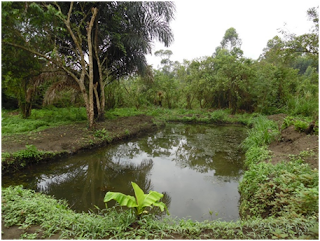 The Tooro Botanical Gardens (TBG) are located to the north of Fort Portal town on the foothills of the Rwenzori Mountains in Western Uganda. Long known for its conservation of native flora and displaying a number of Albertine Rift endemics, the gardens are both an educational and scientifically based organisation.
The Tooro Botanical Gardens (TBG) are located to the north of Fort Portal town on the foothills of the Rwenzori Mountains in Western Uganda. Long known for its conservation of native flora and displaying a number of Albertine Rift endemics, the gardens are both an educational and scientifically based organisation.Perhaps what not many people realise is how rich the gardens are for other fauna including Reptiles, Insects, Mammals and specifically birds. The bird checklist for the gardens stands at 170 a remarkable total for a comparatively small area in a semi-urban area. This short article intends to escort you, the reader through the varied habitats which all have their niche specialists.
 At the Northern gate we have a unique habitat where a stand of Eucalyptus has been encouraged to keep an understory of bushes and shrubs. Mainly Veronia species they provide food and cover for a variety of migrant and resident birds. These include skulking species such as Scaly Francolin, Ludher’s Bush-shrike and Black-faced Rufous Warbler. While in the Eucalypts can be foundmigrantWood, Willow and Reed Warbler, feeding on a myriad of small insects to gain energy for their long journey back to the Northern Hemisphere.
At the Northern gate we have a unique habitat where a stand of Eucalyptus has been encouraged to keep an understory of bushes and shrubs. Mainly Veronia species they provide food and cover for a variety of migrant and resident birds. These include skulking species such as Scaly Francolin, Ludher’s Bush-shrike and Black-faced Rufous Warbler. While in the Eucalypts can be foundmigrantWood, Willow and Reed Warbler, feeding on a myriad of small insects to gain energy for their long journey back to the Northern Hemisphere.To the south of the visitor centre a grass-roofed roundel can be found, overlooking this building is a magnificent Fig tree with Palm’s and Albesia’s surrounding it. This Fig tree is the occasional roost of a pair of Verreaux’s Eagle-Owl. Also in the vicinity of the roundel are some Bottle-brush and Tulip trees, much favoured by various Sunbirds and Flycatchers. We were fortunate this winter period to have at least two Semi-collared Flycatchers, scarce visitors from the Palearctic, use this habitat.
 |
Semi-collared Flycatcher
|
Continuing in a southerly direction we come to a plantation of PrunusAfricana. This well-known medicinal plant is becoming scarce in Africa and TBG’s efforts are to be applauded in safeguarding this plant for future generations. Not only are these good for people but they are sort after by many bird species, mainly Flycatchers and Warblers which feed on the attendant insect life. The low shrubby undergrowth is favoured by another speciality of the gardens the Red-headed Bluebill.
Our final hot-spot is the plant nursery with its surrounding Bottle-brush and Uganda Coral trees. These flowering trees are much favoured by Sunbirds, Waxbills and Flycatchers. While near-by a recently constructed pond is going to be stocked with fish for educational purposes, it is hoped that it will also attract water birds and Kingfishers, already Hamerkop and Woodland Kingfisher have been lured to the ponds by pioneer aquatic life of Frogs and Toads.
You can see TBG is not only a fantastic botanical oasis but home to a spectacular avifauna, which is waiting for you to sample.
 |
| Northern Double-collared Sunbird |
A number of Bi-monthly newsletters have been produced, please ask at reception to view them.
By Roger Q Skeen,
NatureUganda

